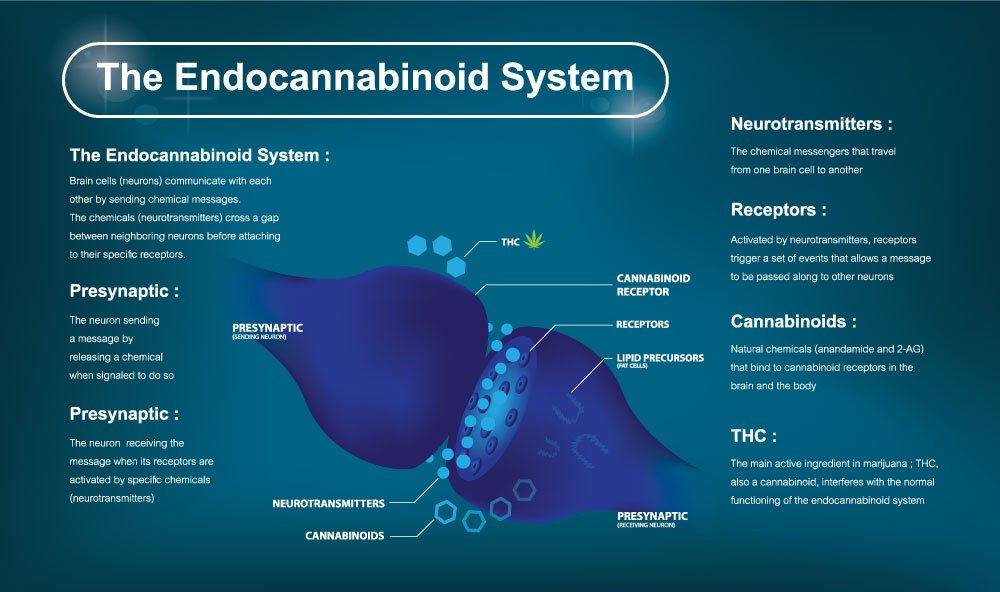It’s no secret that the use of Cannabidiol CBD as a wellness agent is currently taking the world by storm. CBD products are showing up in grocery stores, gas stations, and head shops alike.
While there is little scientific research to back them up, many people credit CBD with helping them to manage a large array of issues from chronic pain, anxiety and mood to even improvements in cardiovascular function.
Just as these therapeutic claims can’t be verified yet, the science behind exactly how CBD interacts in mammals is still in its relative infancy. However, there is a growing body of research that is leading to a much better understanding. In order to understand how CBD interacts within mammals, it’s important to take a step back and look at a little biology.
What is the Endocannabinoid System (ECS)?
In the 1990s, several scientists researching the effects of THC in mammalian brain function stumbled upon the endocannabinoid anandamide. This was followed by the discovery of a second endocannabinoid 2-arachidonoylglycerol (2-AG). These findings ended up leading to the discovery of an unknown molecular cell-signaling system in mammals (one whose function, among many other things, is to help maintain a stable internal environment or balance within the human body). The Endocannabinoid System (ECS) exists primarily to create homeostasis (or balance) to an ever-changing set of environmental factors. It wasn’t until many years later that researchers were able to determine just how broad a range of biological functions was affected.

Just how broad? Research shows that ECS is linked to the following human functions: appetite and digestion, metabolism, chronic pain, inflammation and other immune system responses, mood, learning and memory, motor control, sleep, cardiovascular system function, muscle formation, bone remodeling and growth, liver function, reproductive system function, stress, and nerve function.
CBD has a totally different interaction with the Endocannabinoid System (ECS) than THC does.
Endocannabinoids (or endogenous cannabinoids) are molecules made by mammals that interact with cannabinoid receptors in human cells primarily found in the brain. When an imbalance is detected within our internal environment, the body produces endocannabinoids to interact with these cannabinoid receptors. This, in turn, stimulates the cell (and the body) to return back to a state of homeostasis (or balance). Endocannabinoids and the ECS are some of the neuromodulatory systems found in all mammals.

How do Cannabinoids fit in?
Phytocannabinoids (or Cannabinoids) are molecules found in abundance in the cannabis plant. Phytocannabinoids are the plant equivalent of mammalian endocannabinoids. Most of the phytocannabinoids found in cannabis will, in turn, impact the ECS in much the same way that internally created endocannabinoids do.
For example, the phytocannabinoid Tetrahydrocannabinol (delta9-THC or THC) is responsible for the high associated with the cannabis plant. THC binds directly to both major receptors (CB1 and CB2) in the ECS system. This is what causes a wide range of psychoactive effects in high-THC cannabis (some of which are good and some arguably bad). The good include analgesic and mood enhancement properties, while the bad include anxiety and paranoia (for some).
CBD is different. It is thought that Cannabidiol (CBD) does not actually bind to either CB1 or CB2 receptors as THC does, which may be why it is non-psychoactive in nature. While it’s certainly not considered settled science at this point, it is speculated that CBD acts to prevent endocannabinoids from being broken down. This has a causative effect of those endocannabinoids being more effective in their modulation duties. Another theory is that CBD binds to another, as yet undiscovered receptor. Either way, CBD has a totally different interaction with the ECS than THC does.
Clinical endocannabinoid deficiency (CECD)
A growing body of research is leading many experts to believe in a theory known as CECD. This is, in premise, a defectively functioning ECS which serves as the underlying cause of some chronic disease processes in humans. These ailments can include things such as migraines, fibromyalgia, and other inflammatory diseases. According to this theory, it makes sense that a defective ECS, or one not working optimally, would cause an imbalance in the overall human condition, leading to the onset of diseases and their symptoms.
[It goes without saying, many of the disease processes suggested of involvement, such as migraine and fibromyalgia, have an overall poor pathogenic understanding of origin.]
If CECD is really a thing, and it can be established as the origin of idiopathic disease in humans, then it doesn’t become too much of a stretch to believe that agents or compounds that have an effect on the ECS may hold promise of relief. However, much more research is needed to make such definitive statements.
A few final thoughts
Some of the excitement surrounding CBD, and frankly other phytocannabinoids too, lies within the mystery of its interaction within the ECS. With hemp now legal, the floodgates have opened to scientific research. In time, this will unlock the mystery of how and why CBD should be viewed as a mainstream wellness agent. For now, it’s still a bridge too far.
While this article focused primarily on how CBD interacts in the framework of the ECS, it is by far not the end of the story. In future installments, we will get into how CBD interacts with other neuromodulatory systems.